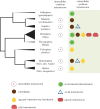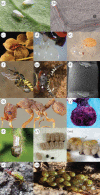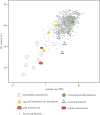An out-of-body experience: the extracellular dimension for the transmission of mutualistic bacteria in insects
- PMID: 25740892
- PMCID: PMC4375872
- DOI: 10.1098/rspb.2014.2957
An out-of-body experience: the extracellular dimension for the transmission of mutualistic bacteria in insects
Abstract
Across animals and plants, numerous metabolic and defensive adaptations are a direct consequence of symbiotic associations with beneficial microbes. Explaining how these partnerships are maintained through evolutionary time remains one of the central challenges within the field of symbiosis research. While genome erosion and co-cladogenesis with the host are well-established features of symbionts exhibiting intracellular localization and transmission, the ecological and evolutionary consequences of an extracellular lifestyle have received little attention, despite a demonstrated prevalence and functional importance across many host taxa. Using insect-bacteria symbioses as a model, we highlight the diverse routes of extracellular symbiont transfer. Extracellular transmission routes are unified by the common ability of the bacterial partners to survive outside their hosts, thereby imposing different genomic, metabolic and morphological constraints than would be expected from a strictly intracellular lifestyle. We emphasize that the evolutionary implications of symbiont transmission routes (intracellular versus extracellular) do not necessarily correspond to those of the transmission mode (vertical versus horizontal), a distinction of vital significance when addressing the genomic and physiological consequences for both host and symbiont.
Keywords: host–microbe coevolution; mutualism stability; symbiont transmission; symbiosis.
© 2015 The Author(s) Published by the Royal Society. All rights reserved.
Figures




Similar articles
-
Versatile and Dynamic Symbioses Between Insects and Burkholderia Bacteria.Annu Rev Entomol. 2020 Jan 7;65:145-170. doi: 10.1146/annurev-ento-011019-025025. Epub 2019 Oct 8. Annu Rev Entomol. 2020. PMID: 31594411 Review.
-
Symbiont-mediated protection in insect hosts.Trends Microbiol. 2009 Aug;17(8):348-54. doi: 10.1016/j.tim.2009.05.005. Epub 2009 Aug 5. Trends Microbiol. 2009. PMID: 19660955 Review.
-
Insect symbionts as hidden players in insect-plant interactions.Trends Ecol Evol. 2012 Dec;27(12):705-11. doi: 10.1016/j.tree.2012.08.013. Epub 2012 Sep 15. Trends Ecol Evol. 2012. PMID: 22985943 Review.
-
Ongoing Transposon-Mediated Genome Reduction in the Luminous Bacterial Symbionts of Deep-Sea Ceratioid Anglerfishes.mBio. 2018 Jun 26;9(3):e01033-18. doi: 10.1128/mBio.01033-18. mBio. 2018. PMID: 29946051 Free PMC article.
-
Partner choice and fidelity stabilize coevolution in a Cretaceous-age defensive symbiosis.Proc Natl Acad Sci U S A. 2014 Apr 29;111(17):6359-64. doi: 10.1073/pnas.1400457111. Epub 2014 Apr 14. Proc Natl Acad Sci U S A. 2014. PMID: 24733936 Free PMC article.
Cited by
-
Unveiling the Microbiome Diversity in Telenomus (Hymenoptera: Scelionidae) Parasitoid Wasps.Insects. 2024 Jun 23;15(7):468. doi: 10.3390/insects15070468. Insects. 2024. PMID: 39057201 Free PMC article.
-
How It All Begins: Bacterial Factors Mediating the Colonization of Invertebrate Hosts by Beneficial Symbionts.Microbiol Mol Biol Rev. 2022 Dec 21;86(4):e0012621. doi: 10.1128/mmbr.00126-21. Epub 2022 Oct 27. Microbiol Mol Biol Rev. 2022. PMID: 36301103 Free PMC article. Review.
-
The Role of Bacterial Symbionts in Triatomines: An Evolutionary Perspective.Microorganisms. 2020 Sep 19;8(9):1438. doi: 10.3390/microorganisms8091438. Microorganisms. 2020. PMID: 32961808 Free PMC article. Review.
-
Bacterial Communities in the Feces of Laboratory Reared Gampsocleis gratiosa (Orthoptera: Tettigoniidae) across Different Developmental Stages and Sexes.Insects. 2022 Apr 7;13(4):361. doi: 10.3390/insects13040361. Insects. 2022. PMID: 35447806 Free PMC article.
-
Can a Symbiont (Also) Be Food?Front Microbiol. 2019 Nov 7;10:2539. doi: 10.3389/fmicb.2019.02539. eCollection 2019. Front Microbiol. 2019. PMID: 31787946 Free PMC article. No abstract available.
References
-
- Buchner P. 1965. Endosymbiosis of animals with plant microorganisms. New York, NY: Interscience.
-
- Ebert D. 2013. The epidemiology and evolution of symbionts with mixed-mode transmission. Annu. Rev. Ecol. Evol. Syst. 44, 623–643. (10.1146/annurev-ecolsys-032513-100555) - DOI
Publication types
MeSH terms
LinkOut - more resources
Full Text Sources
Other Literature Sources
Molecular Biology Databases

